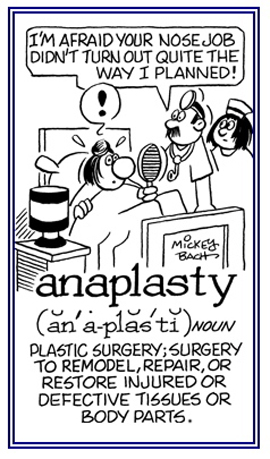plasmo-, plasm-, plast- plasma-, plasmato-, -plasmat-, -plasia, -plasis, -plasm, -plasmatic, -plasmic, -plast, -plastic, -plasy, -plasty
(Greek: made, molded, formed)
The surgical removal of excess flesh from the part of the body that lies between the thorax and the pelvis and encloses the stomach, intestines, liver, spleen, and pancreas: Abdominoplasties are plastic surgeries of the abdomen in which excess fatty tissue and skin are removed, usually for cosmetic reasons.
An abdominoplasty is an operation or "belly tuck" performed on the abdominal wall for esthetic purposes and for the person's self esteem.
It is also called a "tummy tuck" and it can range from a simple "mini-tummy tuck" to a more complicated, extended surgery.
This kind of surgery is not the same as liposuction, another way to remove fat, however abdominal wall surgery is sometimes combined with liposuction.
1. Surgery which is concerned with therapeutic or cosmetic reformation of bodily tissue: The plastic surgeon performed a series of anaplasties on patients desiring the removal of bags under their eyes.
2. The reconstruction or restoration; especially, by plastic surgery, of a lost or injured body part: The anaplasty was successful because the surgeon was able to reposition Victor’s forefinger so that it could serve as a thumb, replacing his severely damaged thumb.
3. The replacement or correction of damaged body parts, organs, etc. with surgery: The eye surgeon was able to perform an anaplasty on the patient, replacing her damaged cornea.

© ALL rights are reserved.
Go to this Word A Day Revisited Index
2. The reconstruction or restoration; especially, by plastic surgery, of a lost or injured body part: The anaplasty was successful because the surgeon was able to reposition Victor’s forefinger so that it could serve as a thumb, replacing his severely damaged thumb.
3. The replacement or correction of damaged body parts, organs, etc. with surgery: The eye surgeon was able to perform an anaplasty on the patient, replacing her damaged cornea.

Go to this Word A Day Revisited Index
for a list of additional Mickey Bach illustrations.
The complete or partial failure of tissue to grow or to develop; arrested or abnormal development: Aplasia is the defective development, or congenital (present at birth) absence, of an organ or tissue.
Dr. Lawson was discussing the aplasia of a localized area of the skin on Tina's scalp which was covered by a thin, almost transparent membrane.
aplastic (adjective), more aplastic, most aplastic
1. A reference to a part of the body that has defective development or growth: The aplastic organ had an incomplete development as in aplastic anemia which occurs when the bone marrow does not provide sufficient red and white blood cell production.
2. Materials that are not easily molded or formed: Wayne, the artist, was working with aplastic materials; such as, stone to create a statue.
2. Materials that are not easily molded or formed: Wayne, the artist, was working with aplastic materials; such as, stone to create a statue.
The surgical reconstructions of the walls of arteries: "Glen had to have arteroplasties so the walls of his arteries could be normalized as much as possible."
A hereditary congenital defect of the joint development: Shane's arthrodysplasias involved abnormal deformities of the movable areas in his legs.
Surgical reconstructions of or replacements of malformed or degenerated connections of the bones that are interconnected: Tamika's physician arranged to have an arthroplasty so she could have artificial joints to replace her painful condition.
bioplast
A functional independent mass of living protoplasm.
blepharoplasty
1. Surgical repair of an eyelid. Often performed for ptosis (drooping of the upper eyelid) of the eyelid.
2. A surgical procedure to reshape (plasty) the upper and lower lids of the eyes.
2. A surgical procedure to reshape (plasty) the upper and lower lids of the eyes.
A blepharoplasty is performed to correct a sagging upper lid that can sometimes interfere with vision and a puffy, baggy lower lid.
cheiloplasty
chondrodysplasia
chondroplasia
cineplasty
cytoplasm
cytoplasmic

